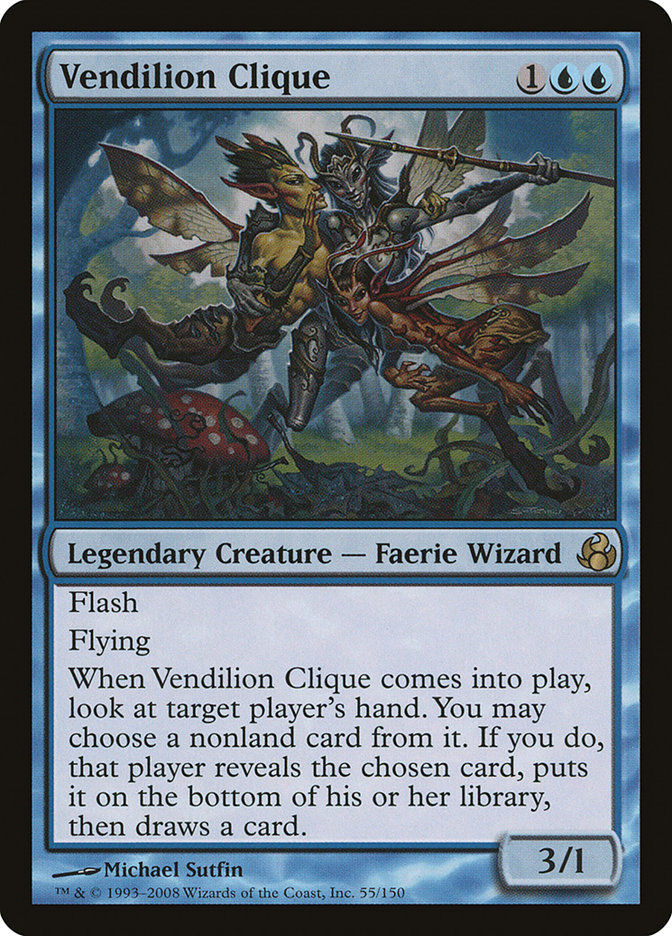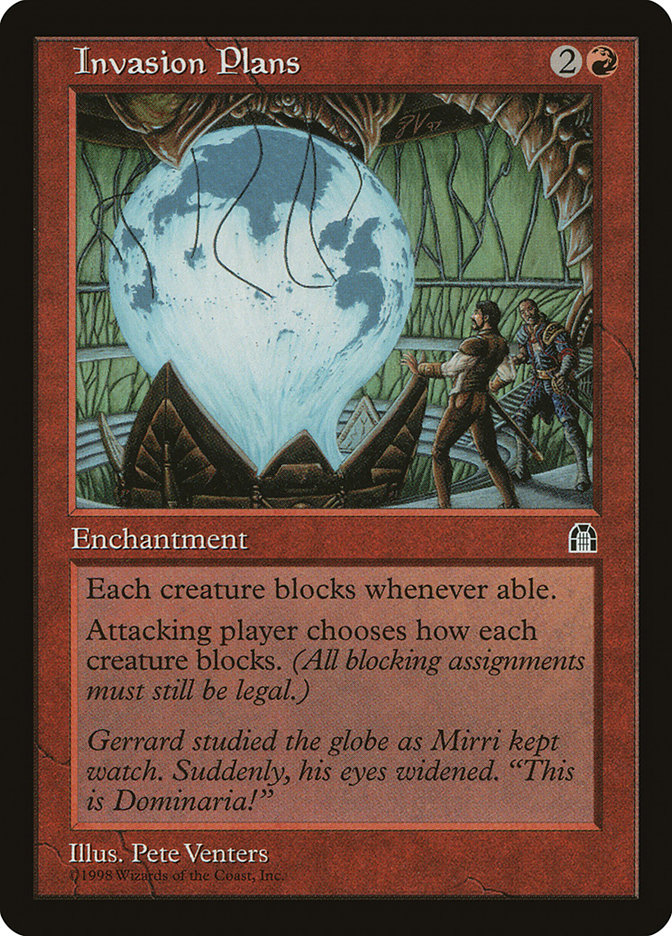Recently I’ve given some thought to what draws new players into Magic, which has developed into one of the most complicated games on the planet over the past two decades. Before learning the nuances of the metagame or even how to tap a Forest for mana, a potential player has to be sold on the game somehow. There has to be something—an image, a name, a phrase—that makes a person go "teach me." (Overeager family and acquaintances are beyond the scope of this article.)
There’s a term that gets thrown around a lot in media-land: "high-concept." Different people have different definitions for it, but its essence, as I understand it, is that a work (this could be a movie, a book, a Magic set, or anything else) is high-concept if most of its appeal can be summarized with a "hook" of just a few words.
Breaking Bad is high-concept because it can be summed up as turning "Mr. Chips into Scarface," as creator Vince Gilligan put it. That’s how he sold the series. Projects both well-executed and poorly-done can be high-concept. Sharknado, a made-for-TV movie of recent vintage, is so flagrantly high-concept that its poster tagline is "Enough said!" In other words, the idea of a "Sharknado" is what the movie has, and if you’re not throwing cash at the project yet, you never will. For years the most obvious example of a high-concept film was the Samuel L. Jackson vehicle Snakes on a Plane.
On the other hand, a film such as Daughters of the Dustis not high-concept; there’s no easy route to pitch a story about women in a Gullah family coming together for a last family meal. The way the film was made, rather than its idea, was what turned it into a classic. In Japanese manga, the Detective Conan / Case Closed series is high-concept ("teenage detective turns into a little kid and solves crimes"), whereas Lucky Stardoesn’t have any one overarching idea.
Magic itself, and by extension the entirety of the trading card game genre, is high-concept—the collectibility of trading cards meets the fun of card games. (Magic’s origins are far more complex, but "collectible fun" is the real secret sauce.) For much of Magic’s history, its settings too have been high-concept. In this article, I’ll look at how Magic, especially in recent sets, is deliberately high-concept and how that high-concept nature is reflected in a favorite Mark Rosewater expression and approach to creating Magic cards: "top-down design."
High-Concept Magic Settings
Mirrodin: "Metal World."
Ravnica: "Prague Covers the Whole World."
Zendikar: "Adventure World."
Innistrad: "Horror World."
Some of the ideas take a little longer to express than others and all of them have the unspoken aspect "with a Magic: The Gathering twist," but within the halls of Wizards and to existing customers, each is a simple pitch. High-concept does not automatically mean mass appeal; while Lorwyn’s idea of "Fairy Tale World" is simple to describe, it also led to Magic being infested with Faeries that gossip and poke people to death in almost every format where they’re legal.
As I told a co-worker at the time, "It’s one thing to get scorched by a huge fireball or trampled by a behemoth. This is death by small, winged, giggling pixies!"
Earlier settings could be high-concept but aren’t necessarily. Arabian Nights? High-concept. Ice Age? High-concept. Mirage? This one’s trickier, but "tropical African world" is close enough for pitch purposes, at least for me. Odyssey is a special case; while its actual setting could be described as "post-apocalyptic continent," the name "Odyssey" supposes a journey, a great voyage home, that doesn’t take place. This is a mismatch between name and setting, though, not a low-concept setting.
Not every Magic setting is high-concept. The plane of Mercadia doesn’t have a single overarching "hook" that sets a tone for the world. ("Smart goblins" doesn’t count.) Among artificial planes, Rath, the setting of Tempest block and the Nemesis set, doesn’t have the same easily graspable concept that "Metal World" Mirrodin does. (Rath is made of this weird rock called flowstone and it’s being used as an experiment ground and future staging point for a Phyrexian invasion of Dominaria and by now you’re going "ugh, show me the cards and I’ll make up my own mind" rather than "shut up and take my money!"
I’ve come to believe, though I cannot prove, that the Magic planes visited during the Weatherlight saga were not as high-concept as later settings because the saga itself was carrying the weight of the storytelling instead. Many illustrations depicted events in a storyline, and much flavor text similarly was straitjacketed.
This would have been fine, except that the storyline had built up over time into a sprawling epic* that makes many fantasy series seem paragons of brevity. From March 1994 (Antiquities, the second expansion of the game) to June 2001 (when the storyline culminated in a dramatic Apocalypse), all expert-level expansions fed, one way or another, into this grand narrative arc of Urza, Mishra, and the knock-on effects of their war. No fewer than thirteen novels tie in directly to this storyline in addition to what’s expressed on the cards and in other places. Before Wikipedia and fan-wikis, there was Phyrexia.com to keep everything straight.
*I’ve come to consider myself spoiled by when I started Magic, which was around the time of Odyssey’s release. I didn’t go through four years of Weatherlight saga, which was a defining space of time for Magic’s storytelling but not one Wizards is particularly keen to repeat. (One could argue that giving story on Magic cards is more important now, not less, because of the lack of Magic novels, but that door is pretty well slammed shut.)
While the current pattern of drastically retooling an existing world or creating a new one whole-cloth each year requires far more effort on the part of Magic Creative (if you’ve never done serious worldbuilding, it’s a beast), the same pattern also has led to more high-concept storytelling, which is easier to sell to customers through taglines ("Deadly perils. Priceless treasures." = Zendikar) and packaging art, not to mention easier to sell within the corporate halls of Wizards. As I’ve said before, Wizards is a business, and it exists to make money. I believe high-concept commercial creativity, wild imagination meeting good stewardship, is the best route Creative can take to make sure that Magic is around for years to come.
In Magic, settings aren’t the only aspects that can be high-concept. Individual cards can be, too, though Wizards of the Coast uses a different expression for them: "top-down design."
Top-Down, High-Concept Design
Ordinarily, Magic cards receive their designs without particular concern for how they’ll be represented (art, name, flavor text) on the cards themselves. The color pie and other aspects of Magic are taken into consideration, of course, but they’re sanity checks rather than driving forces. On a top-down design, by contrast, the card’s mechanics are shaped to suit the flavor rather than the other way around.
For a true understanding of top-down design, Mark Rosewater is a must-read, especially his article "A View from the Top." Another interesting note comes from developer Tom LaPille, who noted that Limited Edition Alpha inherently was designed top-down; in the beginning there was no established system of mechanics for Magic, nor a web of audience expectations, so for the game to be a success the cards had to be relatively simple concepts that would have been encountered previously by almost any fantasy fan.
That same "hook" of familiar fantasy with a twist—called "resonance" in this Mark Rosewater article—informed Magic 2010, the revamp of the core set to an annual product.
A great top-down design is like a beautiful rose growing on a bush, whereas a bottom-up design with strong flavor is like the same beautiful rose plucked and placed in a hat. It’s natural versus artificial beauty, and there are a lot of ugly or just plain "plain" hats out there.
Maybe a peony would go better with this one.
Not every really flavorful card was built top-down, but many of the best were. The luckiest bottom-up cards are the ones where Creative seems to understand an inspiration that was in a designer’s subconscious and everything ends up fitting tighter than Incan masonry.
Postscript: Call for Real-World Flavor Text
I’m sure some of my readers saw Doug Beyer call for certain kinds of real-world flavor text on his Tumblr "A Voice for Vorthos." I’ve shipped off my list to Mr. Beyer already, but in case you were interested in pointing Creative toward a great piece of flavor text according to the challenge laid out, I have a few suggestions.
1) Remember that the writer (or speaker) must be deceased at least 70 years. This is why the "trench poet" Siegfried Sassoon, who survived World War I and lived a good long life after, isn’t eligible to appear on Magic cards, whereas his protege Wilfred Owen, who died a week before the war’s end, appears on a version of Cruel Edict.
Still the only Magic card that can make me cry.
2) The "dead 70 years" rule presents a huge barrier to including the voices of women and men from beyond the European traditions, as they had fewer breakthroughs into lasting literary traditions before the 20th century. It’ll be 2038 (in practice 2039) before Dr. Martin Luther King Jr.‘s words can appear on a Magic card. Langston Hughes becomes eligible only one year earlier, and I can only pray Magic and I live to see the day when Octavia E. Butler‘s voice joins Magic’s chorus. Even so, there’s plenty of material out there.
3) "Quotes" don’t have to mean from books or printed works. Sojourner Truth was a gifted speaker, and I rank Frederick Douglass among the most gifted orators of all time. Chief Joseph and Tecumseh too are notable for certain of their speeches.
4) Many women wrote under male pseudonyms or initials. George Eliot was a woman and a greater writer than I’ll ever be.
Do you have a real-world quote that meets the requirements and might fit a Magic card? Share it in the Facebook comments and with Doug Beyer on Tumblr. Good luck!
As always, thanks for reading.
— JDB
@jdbeety on Twitter





